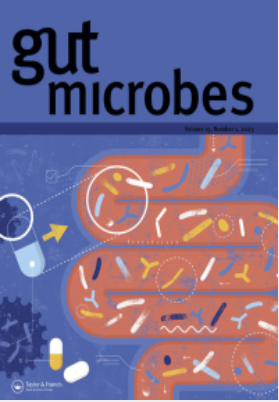Time-restricted feeding protects against septic liver injury by reshaping gut microbiota and metabolite 3-hydroxybutyrate.
IF 11
1区 医学
Q1 GASTROENTEROLOGY & HEPATOLOGY
引用次数: 0
Abstract
Liver injury is an independent risk factor for multiple organ dysfunction and high mortality in patients with sepsis. However, the pathological mechanisms and therapeutic strategies for sepsis-associated liver injury have not been fully elucidated. Time-restricted feeding (TRF) is a promising dietary regime, but its role in septic liver injury remains unknown. Using 16S rRNA gene sequencing, Q200 targeted metabolomics, transcriptomics, germ-free mice, Hmgcs2/Lpin1 gene knockout mice, and Aml12 cells experiments, we revealed that TRF can mitigate septic liver injury by modulating the gut microbiota, particularly by increasing Lactobacillus murinus (L. murinus) abundance, which was significantly reduced in septic mice. Further study revealed that live L. murinus could markedly elevate serum levels of metabolite 3-hydroxybutyrate (3-HB) and alleviate sepsis-related injury, while the knockout of the key enzyme for 3-HB synthesis (3-hydroxy-3-methylglutaryl-CoA synthase 2, Hmgcs2) in the liver negated this protective effect. Additionally, serum 3-HB levels were significantly positively correlated with L. murinus abundance and negatively correlated with liver injury indicators in septic patients, demonstrating a strong predictive value for septic liver injury (AUC = 0.8429). Mechanistically, 3-HB significantly inhibited hepatocyte ferroptosis by activating the PI3K/AKT/mTOR/LPIN1 pathway, reducing ACSL4, MDA, LPO, and Fe2+ levels. This study demonstrates that TRF reduces septic liver injury by modulating gut microbiota to increase L. murinus, which elevates 3-HB to activate PI3K/AKT/mTOR/LPIN1 and inhibit hepatocyte ferroptosis. Overall, this study elucidates the protective mechanism of TRF against septic liver injury and identifies 3-HB as a potential therapeutic target and predictive biomarker, thereby providing new insights into the clinical management and diagnosis of septic liver injury.限时喂养通过重塑肠道微生物群和代谢物 3-hydroxybutyrate 防止脓毒性肝损伤。
肝损伤是脓毒症患者多器官功能障碍和高死亡率的独立危险因素。然而,脓毒症相关肝损伤的病理机制和治疗策略尚未完全阐明。限时喂养(TRF)是一种很有前途的饮食方案,但其在脓毒性肝损伤中的作用尚不清楚。通过16S rRNA基因测序、Q200靶向代谢组学、转录组学、无菌小鼠、Hmgcs2/Lpin1基因敲除小鼠和Aml12细胞实验,我们发现TRF可以通过调节肠道微生物群来减轻脓毒性肝损伤,特别是通过增加脓毒性小鼠的乳酸杆菌(L. murinus)丰度来减轻脓毒性肝损伤。进一步研究发现,活的鼠乳杆菌可显著提高血清代谢物3-羟基丁酸盐(3-hydroxybutyrate, 3-HB)水平,减轻败血症相关损伤,而敲除肝脏中3-HB合成关键酶(3-羟基-3-甲基戊二酰辅酶a合成酶2,Hmgcs2)则否定了这种保护作用。此外,脓毒症患者血清3-HB水平与L. murinus丰度显著正相关,与肝损伤指标呈负相关,对脓毒症肝损伤具有较强的预测价值(AUC = 0.8429)。机制上,3-HB通过激活PI3K/AKT/mTOR/LPIN1通路,降低ACSL4、MDA、LPO和Fe2+水平,显著抑制肝细胞铁下垂。本研究表明,TRF通过调节肠道菌群增加L. murinus,使3-HB升高,激活PI3K/AKT/mTOR/LPIN1,抑制肝细胞铁凋亡,从而减轻脓毒性肝损伤。总的来说,本研究阐明了TRF对脓毒性肝损伤的保护机制,并确定了3-HB作为潜在的治疗靶点和预测性生物标志物,从而为脓毒性肝损伤的临床管理和诊断提供了新的见解。
本文章由计算机程序翻译,如有差异,请以英文原文为准。
求助全文
约1分钟内获得全文
求助全文
来源期刊

Gut Microbes
Medicine-Microbiology (medical)
CiteScore
18.20
自引率
3.30%
发文量
196
审稿时长
10 weeks
期刊介绍:
The intestinal microbiota plays a crucial role in human physiology, influencing various aspects of health and disease such as nutrition, obesity, brain function, allergic responses, immunity, inflammatory bowel disease, irritable bowel syndrome, cancer development, cardiac disease, liver disease, and more.
Gut Microbes serves as a platform for showcasing and discussing state-of-the-art research related to the microorganisms present in the intestine. The journal emphasizes mechanistic and cause-and-effect studies. Additionally, it has a counterpart, Gut Microbes Reports, which places a greater focus on emerging topics and comparative and incremental studies.
 求助内容:
求助内容: 应助结果提醒方式:
应助结果提醒方式:


